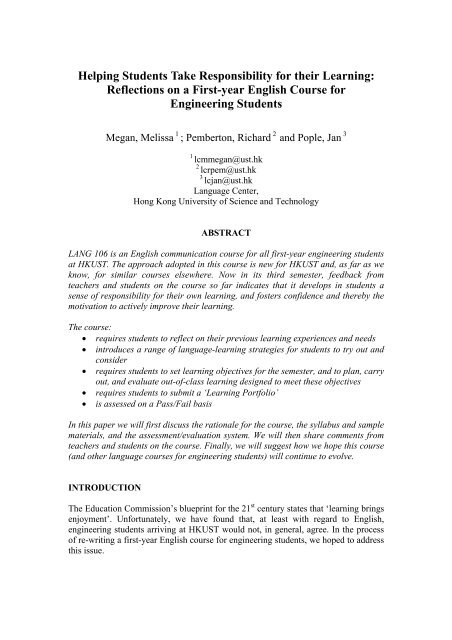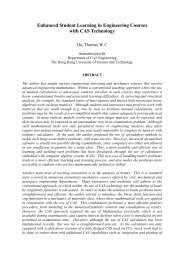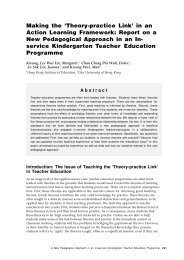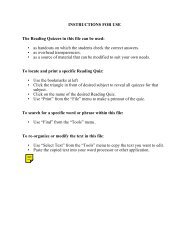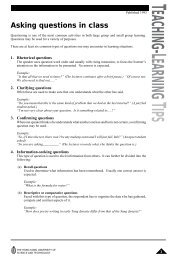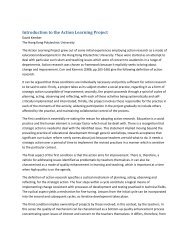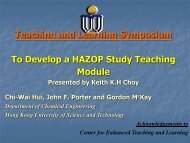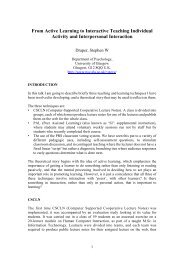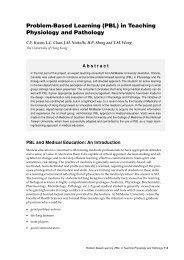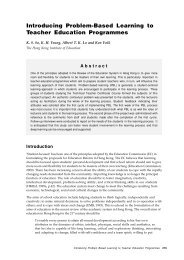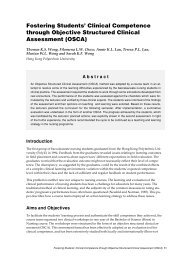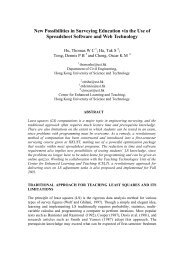The Education Commission's blueprint for the 21st century states that
The Education Commission's blueprint for the 21st century states that
The Education Commission's blueprint for the 21st century states that
Create successful ePaper yourself
Turn your PDF publications into a flip-book with our unique Google optimized e-Paper software.
Helping Students Take Responsibility <strong>for</strong> <strong>the</strong>ir Learning:Reflections on a First-year English Course <strong>for</strong>Engineering StudentsMegan, Melissa 1 ; Pemberton, Richard 2 and Pople, Jan 31lcmmegan@ust.hk2lcrpem@ust.hk3lcjan@ust.hkLanguage Center,Hong Kong University of Science and TechnologyABSTRACTLANG 106 is an English communication course <strong>for</strong> all first-year engineering studentsat HKUST. <strong>The</strong> approach adopted in this course is new <strong>for</strong> HKUST and, as far as weknow, <strong>for</strong> similar courses elsewhere. Now in its third semester, feedback fromteachers and students on <strong>the</strong> course so far indicates <strong>that</strong> it develops in students asense of responsibility <strong>for</strong> <strong>the</strong>ir own learning, and fosters confidence and <strong>the</strong>reby <strong>the</strong>motivation to actively improve <strong>the</strong>ir learning.<strong>The</strong> course:• requires students to reflect on <strong>the</strong>ir previous learning experiences and needs• introduces a range of language-learning strategies <strong>for</strong> students to try out andconsider• requires students to set learning objectives <strong>for</strong> <strong>the</strong> semester, and to plan, carryout, and evaluate out-of-class learning designed to meet <strong>the</strong>se objectives• requires students to submit a ‘Learning Portfolio’• is assessed on a Pass/Fail basisIn this paper we will first discuss <strong>the</strong> rationale <strong>for</strong> <strong>the</strong> course, <strong>the</strong> syllabus and samplematerials, and <strong>the</strong> assessment/evaluation system. We will <strong>the</strong>n share comments fromteachers and students on <strong>the</strong> course. Finally, we will suggest how we hope this course(and o<strong>the</strong>r language courses <strong>for</strong> engineering students) will continue to evolve.INTRODUCTION<strong>The</strong> <strong>Education</strong> Commission’s <strong>blueprint</strong> <strong>for</strong> <strong>the</strong> 21 st <strong>century</strong> <strong>states</strong> <strong>that</strong> ‘learning bringsenjoyment’. Un<strong>for</strong>tunately, we have found <strong>that</strong>, at least with regard to English,engineering students arriving at HKUST would not, in general, agree. In <strong>the</strong> processof re-writing a first-year English course <strong>for</strong> engineering students, we hoped to addressthis issue.
Stories from first-year engineering students suggest no kind of link betweenenjoyment and <strong>the</strong>ir previous learning of English. Most report <strong>that</strong> <strong>the</strong>ir experienceshave been largely exam-focused and classrooms teacher-centered. Most engineeringstudents start at UST having just completed <strong>the</strong>ir secondary schooling. In <strong>the</strong>ir ‘Use ofEnglish’ examination most obtained a D or E grade. If we accept <strong>the</strong> A-level Englishexams as a valid measure of effective learning of English, we must <strong>the</strong>n conclude <strong>that</strong><strong>the</strong>se students have not learned English very well. Perhaps of even more concern,however, is <strong>that</strong> in terms of learning-how-to-learn, ironically, all <strong>the</strong> evidencesuggests <strong>that</strong> students have learned little more than how to take exams.With all this in mind, we set out to develop a course <strong>that</strong> would promote responsibility,foster confidence and motivation, and <strong>the</strong>reby result in both learning and enjoymentof English.COURSE OVERVIEWLANG 106 was first offered in <strong>the</strong> Fall Semester of 2000. It is a two-part courseacross <strong>the</strong> Fall and Spring semesters. Ra<strong>the</strong>r than attempting to teach particular skillsand sub-skills or focusing primarily on academic texts and associated tasks, <strong>the</strong>emphasis of <strong>the</strong> course is on developing students’ learning strategies. Students arerequired to submit a learning portfolio at <strong>the</strong> end of each semester and assessment ispass/fail.A Strategies-based ApproachAs suggested above, we had become increasingly concerned about <strong>the</strong> limited rangeof learning strategies <strong>that</strong> most first-year students appear to have at <strong>the</strong>ir disposal. Asis pointed out in <strong>the</strong> <strong>Education</strong> Commission’s re<strong>for</strong>m documents, most of our studentshave been exposed to excessive mechanical drilling and numerous tests andexaminations in <strong>the</strong>ir previous learning of English. We do not feel <strong>that</strong> it is unjust tosuggest <strong>that</strong> <strong>the</strong>se kinds of teaching practice result in learners who are reasonablyproficient at memorizing materials <strong>for</strong> exams but not at communicating in English.<strong>The</strong> underlying premise of strategies-based instruction is <strong>that</strong> language learning willbe facilitated if students are more aware of <strong>the</strong> huge range of possible strategies <strong>that</strong><strong>the</strong>y might consciously choose from during language learning and use. A strategiesbasedapproach to teaching is a ‘learner-focused method of instruction <strong>that</strong>emphasizes both <strong>the</strong> what and how of learning’ (Weaver & Cohen 1997:iii). Inherentin this shift of focus (to <strong>the</strong> learner) is a shift in <strong>the</strong> responsibilities of both teachersand students.Course ContentResearch indicates <strong>that</strong> at least at <strong>the</strong> outset, ‘explicit instruction in <strong>the</strong> development,application and transfer of language learning strategies is preferable to implicitinstruction’ (Weaver & Cohen 1998:67). That said, we would like to emphasize <strong>that</strong>strategies are nei<strong>the</strong>r inherently ‘good’ nor ‘effective’ but need to be evaluated by
individual learners who have specific learning objectives and are contemplatingparticular language learning/use tasks.<strong>The</strong>re<strong>for</strong>e, in our course, while we do offer students particular strategies <strong>for</strong> readingand listening (Fall Semester) and writing and speaking (Spring Semester), we alsooffer opportunities and guidance <strong>for</strong> students to:1. Self-diagnose <strong>the</strong>ir needs across <strong>the</strong> four language skills.2. Experiment with both familiar and unfamiliar strategies.3. Make decisions about how to approach a language-learning task.4. Evaluate and reflect on both <strong>the</strong>ir progress (skills development) and <strong>the</strong>effectiveness of <strong>the</strong>ir learning.Course Requirements and AssessmentAs previously mentioned, students are awarded a pass or fail grade <strong>for</strong> LANG 106.From <strong>the</strong> outset, we felt <strong>that</strong> it was imperative <strong>that</strong> this course be assessed on apass/fail basis so <strong>that</strong> students could be encouraged to focus on <strong>the</strong>ir own learning,ra<strong>the</strong>r than on <strong>the</strong>ir position in relation to <strong>the</strong>ir peers. While we are aware <strong>that</strong> <strong>the</strong>re isincreasing public and political pressure on educational institutions in Hong Kong toexplain what <strong>the</strong>y are trying to do and to demonstrate how well <strong>the</strong>y are doing it, weare convinced <strong>that</strong> continuing <strong>the</strong> competitive focus on grades would undermine all<strong>that</strong> we hope to achieve in this course.As should be already clear, we are most interested <strong>the</strong> language learning process.Secondly, we feel <strong>that</strong> it is <strong>the</strong> students who should be asking <strong>the</strong>mselves ‘How wellam I learning?’Students are required to submit a Learning Portfolio at <strong>the</strong> end of each semester. In<strong>the</strong> Fall Semester, this comprises four pieces of ‘reflective’ writing:1. ‘Me, as a learner of English’This task requires students to reflect on <strong>the</strong>ir personalities and <strong>the</strong>ir learningexperiences. We believe <strong>that</strong> students’ later assessments of <strong>the</strong> learning <strong>that</strong> <strong>the</strong>yhave done through participation in LANG 106 depend fairly heavily on <strong>the</strong>irperceptions of <strong>the</strong>mselves and <strong>the</strong>ir previous learning of English at <strong>the</strong> beginningof <strong>the</strong> semester. In o<strong>the</strong>r words, students establish <strong>the</strong>ir ‘starting point’ <strong>for</strong> LANG106.2. ‘A reading task to plan, complete and report on’This task requires students to plan (make decisions about personal objectives aswell as materials and strategies to use), carry out, evaluate and reflect on alanguage-learning experience.3. ‘A listening task to plan, complete and report on’This task is similar to Task 2.
4. ‘A final report’This is <strong>the</strong> students’ final ‘assessment’ of <strong>the</strong>ir learning <strong>for</strong> <strong>the</strong> semester. Itrequires students to reflect on <strong>the</strong>ir achievement of personal objectives and <strong>the</strong>irstrategy use. In this report, students also suggest plans <strong>for</strong> future learning.<strong>The</strong> following three criteria are used by teachers when looking at portfolios anddeciding whe<strong>the</strong>r to award a pass or fail grade:• Depth of thought/understanding• Relevance to learning objectives• Clarity and elaborationFEEDBACKJust as we are convinced <strong>that</strong> grading would not be appropriate <strong>for</strong> this course, we areconfident <strong>that</strong> a lack of grades does not mean <strong>that</strong> we cannot evaluate and reviewLANG 106. Our evaluative data is of a different kind.From Students (quantitative data)At <strong>the</strong> end of <strong>the</strong> Fall Semester 2000 a post-course questionnaire was given tostudents. Section 1 of <strong>the</strong> questionnaire asked students to rate <strong>the</strong>ir level of agreementwith ten statements, such as ‘I now have a more positive attitude towards learningEnglish’. Analysis of student responses to this and o<strong>the</strong>r statements was encouraging.From Students (qualitative data)<strong>The</strong> following comments are taken from students’ portfolios as well as Section 2 of<strong>the</strong> post-course questionnaire (open-ended questions).ResponsibilityComments of <strong>the</strong> following kind suggest <strong>that</strong> students appreciate <strong>the</strong>ir (new)‘freedom’.“LANG 106 is always my favorite lesson at UST. I like this class because I foundmyself a university student when I attend <strong>the</strong> class. In <strong>the</strong> past learning was asend-receive process. We had little freedom in choosing what we want to learn orwhich way to learn”“<strong>The</strong> best part of <strong>the</strong> course is <strong>the</strong> freedom it gives us. <strong>The</strong>re are no limitations atall, as long as we fulfill some requirements. I can never think <strong>that</strong> I can watchmovie as a task, and do something <strong>that</strong> I was really interested in”
Confidence/MotivationMuch has been written about <strong>the</strong> role and kinds of motivation in language learning.We take <strong>the</strong> position <strong>that</strong> generally any factors <strong>that</strong> motivate our students to learn willresult in increased acquisition of English. We also believe in an intrinsic link betweenconfidence and motivation. This link manifests itself most obviously when studentslack confidence. For example, <strong>the</strong> student who lacks confidence in his/her ability tochoose appropriate learning strategies will seldom appear motivated to experimentwith different strategies. Much research has found <strong>that</strong> more motivated learners reportusing a greater range of strategies more often than less motivated students (see, <strong>for</strong>example, Megan 1997).Comments of <strong>the</strong> following kind suggest <strong>that</strong> our course enhances learner confidenceand motivation.“My attitudes to learning English become very positive. In <strong>the</strong> past, opening mymouth was very difficult and I was very nervous when I spoke in English and <strong>the</strong>purpose of previous learning was just to pass <strong>the</strong> exams, but now I learn English<strong>for</strong> myself. I really want to learn English and opening my mouth is easy now”“Self motivation is very important <strong>for</strong> learning English because in <strong>the</strong> past Idisliked English and hence had no self-motivation”From TeachersAs this approach requires learners to take responsibility <strong>for</strong> <strong>the</strong>ir own learning, <strong>the</strong>language instructor <strong>the</strong>n takes on more of a supporting role as students strive toachieve personal objectives. Comments from teachers would suggest <strong>that</strong> <strong>the</strong>y likethis new role and believe in <strong>the</strong> value of <strong>the</strong> approach.“I’m enjoying myself teaching this course and I think <strong>for</strong> some students it’s abreath of fresh air”“ <strong>The</strong> materials have proved challenging, motivating and fun…so I’ve enjoyed <strong>the</strong>classes and it has certainly encouraged and ‘thought provoked’ students”“That we are solidly involving students in self-access tasks and reflection <strong>for</strong>independent learning, ra<strong>the</strong>r than just talking about doing it, is excellent; it is astrategy well suited to, even necessary <strong>for</strong>, student language improvement given<strong>the</strong> in-class time available to us”“Students were more motivated than in previous years”
THE FUTUREWe continue to evaluate <strong>the</strong> course. We are currently making changes to <strong>the</strong> SpringSemester component to bring it more in line with <strong>the</strong> approach adopted in <strong>the</strong> FallSemester.Given current moves and educational re<strong>for</strong>ms taking place in Hong Kong, we hope<strong>that</strong> in <strong>the</strong> future <strong>the</strong> learning experiences offered to students in LANG 106 will not beso radically different from those <strong>that</strong> <strong>the</strong>y have had at o<strong>the</strong>r levels of <strong>the</strong>ir schooling.Never<strong>the</strong>less, we feel sure <strong>that</strong> LANG 106 will continue to play an important part inestablishing not only ways of learning but also ways of thinking about learning <strong>for</strong>students and <strong>that</strong> <strong>the</strong>se ways will have significance <strong>for</strong> students throughout <strong>the</strong>ir timeat UST and beyond.Links with O<strong>the</strong>r Courses <strong>for</strong> Engineering Students (LANG 206 and 306)O<strong>the</strong>r language courses <strong>for</strong> engineering students already offer some learningexperiences similar to those of <strong>the</strong> LANG 106 course. For example, <strong>the</strong> LANG 306course now includes a self-access writing project. This project requires students todiagnose <strong>the</strong>ir writing needs and plan <strong>for</strong> improvement by choosing a grammar‘pathway’. It is our hope <strong>that</strong> similar projects will be created in LANG 206 so <strong>that</strong>students can learn to take responsibility <strong>for</strong> <strong>the</strong>ir learning of English throughout <strong>the</strong>irthree years at UST.We feel <strong>that</strong> this will be dependent on decisions made about grading systems used in<strong>the</strong> two courses and hope <strong>that</strong> like LANG 106, at some time in <strong>the</strong> future, both LANG206 and 306 might also be pass/fail courses.Learning English Brings Enjoyment!Most of all, we hope <strong>that</strong> we can state with confidence in <strong>the</strong> future <strong>that</strong> our studentsbelieve <strong>that</strong> learning English brings enjoyment. Feedback already received wouldindicate <strong>that</strong> we are on <strong>the</strong> right track.REFERENCESHong Kong Special Administrative Region <strong>Education</strong> Commission. (1999). Review of<strong>Education</strong> System: Framework <strong>for</strong> <strong>Education</strong> Re<strong>for</strong>m. Learning <strong>for</strong> Life. <strong>Education</strong><strong>blueprint</strong> <strong>for</strong> <strong>the</strong> 21 st <strong>century</strong>.Megan, M (1997). Autonomy in <strong>the</strong> Global Classroom: Self-Directive LearningStrategies used by EFS/EAP Students. In Proceedings of <strong>the</strong> 10 th Annual EA<strong>Education</strong> Conference, pp. 185-196. Sydney: ELICOS Association Ltd.
Weaver, S J & Cohen, A D (1997). Strategies-Based Instruction: A Teacher-TrainingManual. CARLA Working Paper Series #7. Center <strong>for</strong> Advanced Research onLanguage Acquisition, Institute of International Studies and Programs, University ofMinnesota.Weaver, S J & Cohen, A D (1998). Making Strategy Training a Reality in <strong>the</strong> ForeignLanguage Curriculum. In A.D. Cohen, Strategies in Learning and Using a SecondLanguage, pp. 67-97. New York: Addison Wesley Longman Inc.


